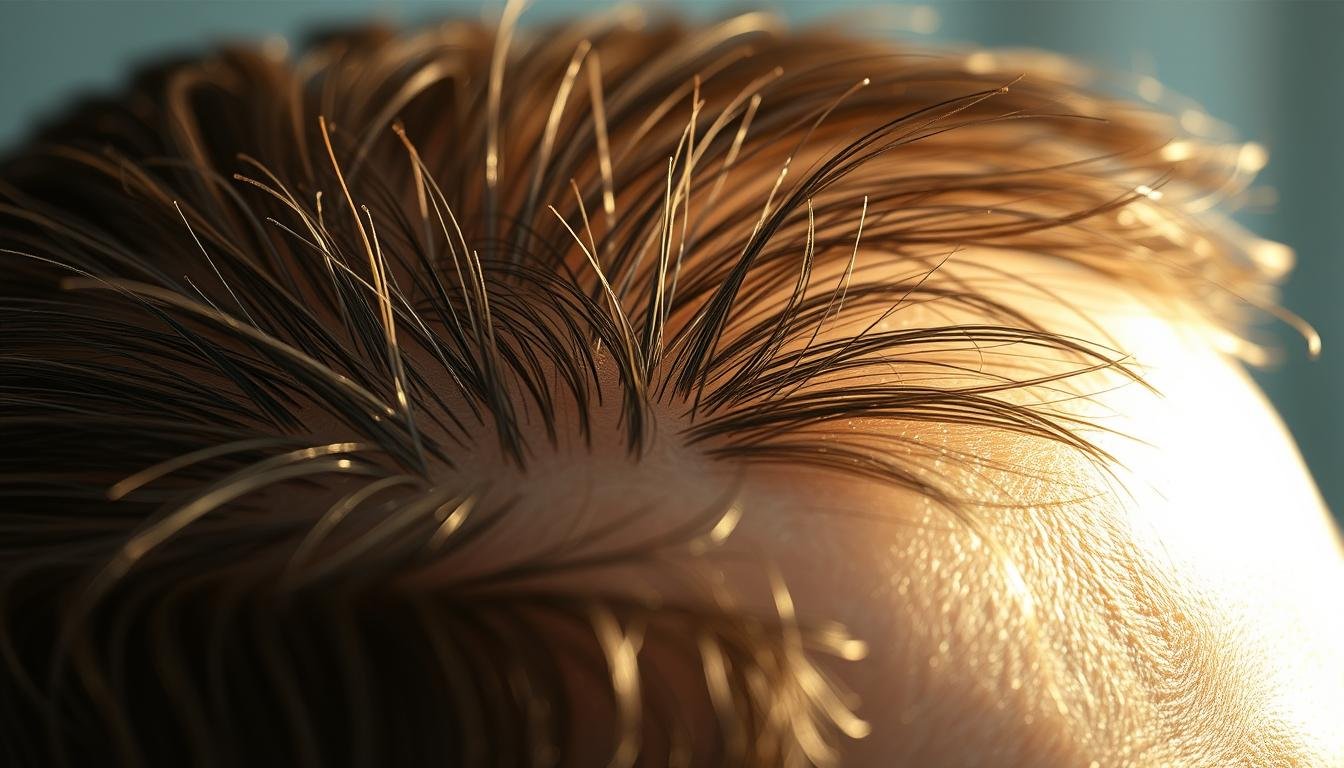Can Hair Grow Back After Balding? | Latest Research
Did you know that nearly 85% of men will experience significant hair thinning by the age of 50? This startling statistic highlights the widespread nature of hair loss, a condition that affects millions of individuals worldwide. However, the question remains: can hair grow back after balding, or is it a permanent condition? In this article, we’ll dive into the latest research and explore the possibilities of hair regrowth, providing you with a comprehensive understanding of this complex topic.
Key Takeaways
- Hair Loss can have various underlying causes, including genetic factors, environmental triggers, and medical conditions.
- While some forms of hair loss are reversible, others may lead to permanent balding.
- Emerging treatments and therapies are showing promising results in stimulating hair regrowth.
- Lifestyle changes and natural remedies can also play a role in supporting hair health and regrowth.
- Early intervention and seeking professional help are crucial for the best chances of successful hair restoration.
Understanding Hair Loss: Types and Causes
Hair Loss, also known as alopecia, can take various forms and have diverse underlying causes. While male pattern baldness is a common type of hair thinning, there are several other forms of hair loss that warrant attention. understanding the different types and their associated factors is crucial in addressing the issue effectively.
Male Pattern Baldness vs. Other Forms of Hair Loss
Male pattern baldness, or androgenetic alopecia, is the most prevalent type of hair loss, affecting up to 50% of men by the age of 50. This genetic condition is characterized by a receding hairline and gradual thinning of hair on the crown and top of the head. In contrast, Alopecia areata is an autoimmune disorder that causes patchy hair loss, while telogen effluvium is a temporary shedding of hair often triggered by Stress, illness, or medication.
Genetic Factors in Hair Loss
Genetics play a significant role in determining an individual’s susceptibility to hair loss. Studies have identified several genetic variants associated with an increased risk of Alopecia, including those involved in the regulation of hair follicle growth and androgen sensitivity. Individuals with a family history of hair loss are more likely to experience similar patterns of balding.
Environmental Triggers
While genetics lay the groundwork for hair loss, environmental factors can also contribute to the problem. Factors such as Stress, poor nutrition, hormonal imbalances, and certain medications can disrupt the natural hair growth cycle, leading to increased shedding or thinning of hair. Identifying and addressing these triggers can be crucial in managing hair loss effectively.

| Hair Loss Type | Characteristics | Causes |
|---|---|---|
| Male Pattern Baldness | Receding hairline, thinning on crown | Genetic, hormonal |
| Alopecia Areata | Patchy hair loss | Autoimmune disorder |
| Telogen Effluvium | Temporary, diffuse hair shedding | Stress, illness, medication |
“Understanding the different types of hair loss and their underlying causes is the first step in developing an effective treatment plan.”
The Science Behind Hair Growth Cycles
To fully understand the potential for hair regrowth after balding, it’s crucial to delve into the intricate science behind the hair growth cycle. This natural cycle is comprised of three distinct phases: anagen, catagen, and telogen.
The anagen phase is the active growth stage, where hair follicles are actively producing new hair strands. This phase can last anywhere from 2 to 7 years, during which time the hair grows approximately 1 centimeter per month. The catagen phase is a transitional stage, where the hair follicle prepares to enter the resting phase. This phase typically lasts 1-2 weeks.
Finally, the telogen phase is the resting stage, where the hair follicle remains dormant for 2-4 months. During this time, the old hair strand is shed, and the cycle begins anew with the anagen phase.
Understanding these hair growth cycles is essential for comprehending the potential for hair regrowth after balding. By recognizing the various stages and their durations, healthcare professionals can better identify the underlying causes of hair loss and develop targeted treatment strategies to promote healthy hair follicles and stimulate new growth.
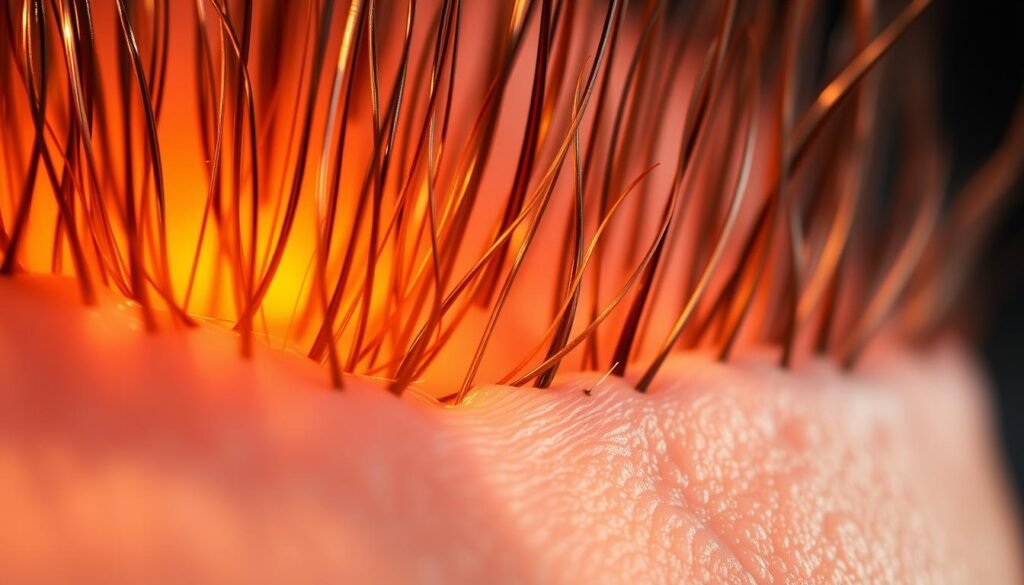
| Phase | Duration | Description |
|---|---|---|
| Anagen | 2-7 years | Active growth stage where new hair is produced |
| Catagen | 1-2 weeks | Transitional stage where the hair follicle prepares to enter the resting phase |
| Telogen | 2-4 months | Resting stage where the old hair strand is shed, and the cycle begins anew |
“Understanding the hair growth cycle is key to unlocking the secrets of hair regrowth and addressing the root causes of balding.”
Can Hair Grow Back After Balding?
Hair loss and balding can be a distressing experience, but the good news is that in many cases, hair can regrow. The key is understanding the underlying causes of hair shedding and the natural hair growth cycle.
Natural Regrowth Possibilities
In some instances, hair can regrow naturally without any medical intervention. This often occurs when the hair loss is caused by temporary factors, such as stress, nutritional deficiencies, or hormonal changes. With proper management of the underlying issue, the hair can often resume its normal growth cycle, leading to new hair growth.
Medical Intervention Success Rates
For more persistent or severe cases of hair loss, medical treatments can be highly effective in stimulating hair regrowth. FDA-approved medications, such as minoxidil and finasteride, have been shown to help restore hair in many individuals. Emerging therapies, like platelet-rich plasma (PRP) injections and low-level laser therapy, are also proving promising in clinical studies.
Timeline for Potential Recovery
- In cases of temporary hair shedding, new hair growth can typically be seen within 3-6 months with proper treatment and management of the underlying cause.
- For more chronic forms of hair loss, such as male or female pattern baldness, it may take 6-12 months of consistent medical treatment to start seeing significant hair regrowth.
- The exact timeline for hair recovery can vary greatly depending on the individual, the type and severity of hair loss, and the effectiveness of the chosen treatment approach.
Remember, with patience, persistence, and the right combination of medical care and lifestyle adjustments, many individuals can experience a successful recovery of their hair after balding or excessive shedding.
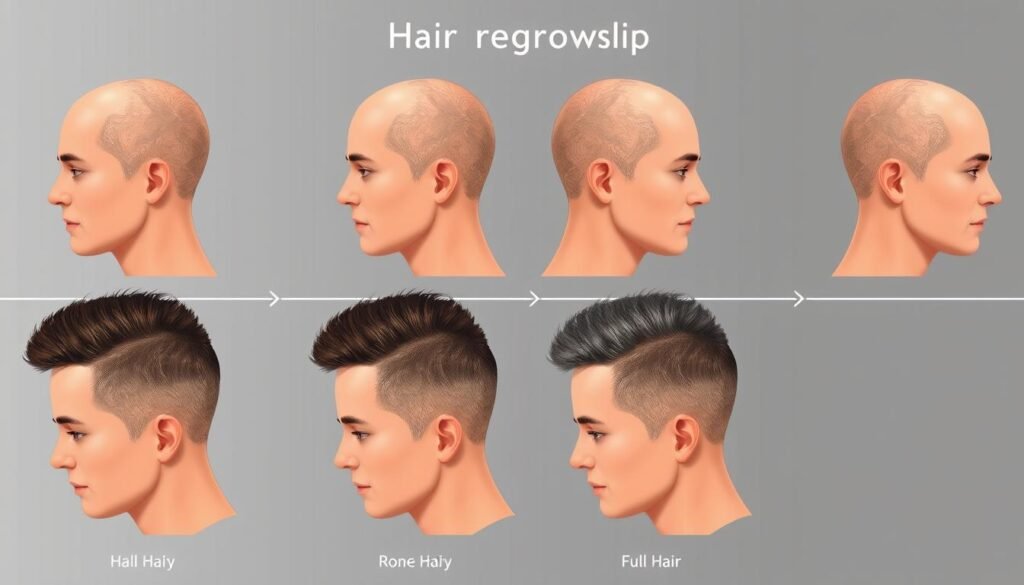
The Role of Stress in Hair Loss and Regrowth
Stress is a significant factor in hair loss and regrowth. When individuals experience high levels of stress, their bodies produce increased amounts of the hormone cortisol, which can have a detrimental impact on hair follicles.
Elevated cortisol levels can disrupt the normal hair growth cycle, leading to increased shedding and slower regrowth. This phenomenon, known as telogen effluvium, is a common type of stress-induced hair loss. Fortunately, managing stress can be an essential step in promoting hair regrowth and regaining a healthy scalp.
Stress Management Techniques for Hair Regrowth
Incorporating stress management techniques into one’s daily routine can be a valuable approach to supporting hair regrowth. Some effective strategies include:
- Regular exercise, such as yoga, meditation, or other relaxing physical activities
- Practicing mindfulness and deep breathing exercises to reduce anxiety
- Engaging in hobbies and activities that bring joy and a sense of calm
- Seeking support from friends, family, or a mental health professional, if needed
By addressing the underlying stress and implementing effective stress management techniques, individuals can potentially mitigate the negative impact of cortisol on their hair and promote a healthier, more resilient scalp environment for hair regrowth.
| Stress Level | Cortisol Levels | Impact on Hair Growth |
|---|---|---|
| Low | Normal | Hair growth cycles maintain a healthy balance |
| High | Elevated | Increased shedding and slower regrowth (telogen effluvium) |
It is important to note that while stress management can be beneficial, it is not a guaranteed solution for all types of hair loss. Individuals experiencing significant or persistent hair loss should consult with a dermatologist or hair loss specialist to explore a comprehensive treatment plan.

“Stress can have a significant impact on our hair, but by prioritizing self-care and implementing effective stress management techniques, we can support a healthier scalp environment and promote hair regrowth.”
Medical Treatments and Their Effectiveness
In the quest to regain lost hair, medical treatments have emerged as a promising solution. Among the FDA-approved medications, minoxidil and finasteride have garnered significant attention for their ability to promote hair regrowth. However, the effectiveness of these treatments can vary depending on the individual and the severity of their hair loss.
FDA-Approved Medications
Minoxidil, commonly known as Rogaine, is a topical solution that is applied directly to the scalp. It works by stimulating the follicles and increasing blood flow to the hair roots. Studies have shown that minoxidil can be effective in slowing down hair loss and promoting partial regrowth, with a success rate of around 60% in some cases.
Finasteride, on the other hand, is an oral medication that blocks the conversion of testosterone to dihydrotestosterone (DHT), a primary culprit in male pattern baldness. This medication has been found to be effective in preventing further hair loss and even promoting regrowth in some individuals, with a success rate of up to 90% in certain cases.
Emerging Therapies
In recent years, PRP (Platelet-Rich Plasma) therapy has emerged as a promising treatment option for hair loss. This innovative approach involves extracting the patient’s own blood, separating the platelets, and then injecting the concentrated platelet-rich plasma back into the scalp. The growth factors in the plasma are believed to stimulate the dormant follicles and promote new hair growth. Preliminary studies have shown promising results, with some patients experiencing a significant increase in hair density and thickness.
Treatment Success Rates
The success rates of these medical treatments can vary depending on several factors, such as the individual’s age, the severity of hair loss, and the consistency of the treatment. While FDA-approved medications like minoxidil and finasteride have shown positive results, the effectiveness can range from 60% to 90%. Emerging therapies like PRP have also demonstrated encouraging outcomes, but more long-term studies are still needed to determine their overall success rates.
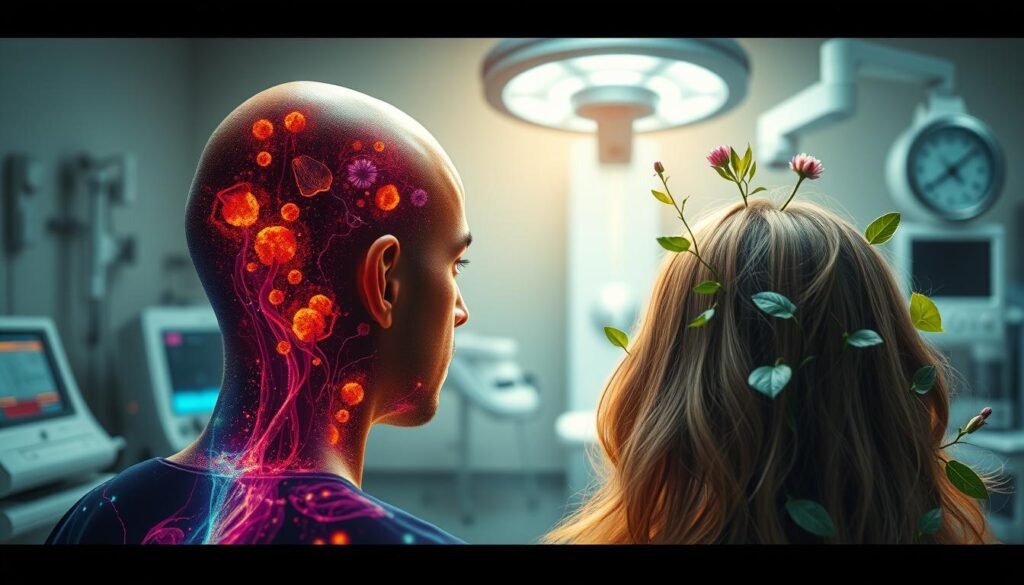
It is important to note that the effectiveness of any hair loss treatment can be influenced by individual factors, and a comprehensive evaluation by a qualified healthcare professional is essential to determine the most suitable approach. By understanding the various medical treatments and their effectiveness, individuals can make informed decisions and take proactive steps towards restoring their hair health.
Natural Remedies and Lifestyle Changes
When it comes to hair regrowth, natural remedies and lifestyle modifications can play a crucial role. From the use of essential oils to scalp massages, these holistic approaches may help stimulate hair follicles and promote healthier hair growth.
Essential Oils for Hair Health
Certain essential oils, such as rosemary, peppermint, and lavender, have been studied for their potential benefits in supporting hair regrowth. These potent plant-derived oils may help improve blood circulation to the scalp and nourish the hair follicles, leading to stronger, healthier hair.
Scalp Massage Techniques
Regularly massaging the scalp can be a simple yet effective way to encourage hair growth. The gentle, circular motions help increase blood flow and stimulate the follicles, potentially leading to improved hair density and thickness over time.
- Use fingertips to massage the scalp in small, circular motions
- Focus on areas with thinning or balding spots
- Incorporate essential oils for added benefits
Lifestyle Factors to Consider
In addition to natural remedies, certain lifestyle choices can also impact hair health and regrowth. Factors such as stress management, nutrition, and adequate sleep can all play a role in maintaining a healthy scalp and hair follicles.
- Manage stress through relaxation techniques, such as meditation or yoga
- Ensure a balanced diet rich in essential nutrients for hair growth
- Prioritize quality sleep to support the body’s natural hair growth cycles
By incorporating a combination of natural remedies and lifestyle modifications, individuals with balding or thinning hair may be able to stimulate regrowth and achieve a fuller, healthier head of hair.

“Treating the scalp holistically with natural remedies and lifestyle changes can be a powerful approach to addressing hair loss and promoting regrowth.”
The Impact of Diet and Nutrition on Hair Regrowth
Your hair’s health and growth are directly influenced by the nutrients you consume. Certain vitamins, minerals, and fatty acids play a vital role in maintaining strong, healthy hair. By understanding the essential nutrients for hair health, you can tailor your diet to support hair regrowth after balding.
Essential Nutrients for Hair Health
Three key nutrients stand out when it comes to supporting hair growth:
- Biotin, also known as vitamin B7, helps the body convert food into energy and promotes the production of keratin, a crucial structural component of hair.
- Iron is essential for carrying oxygen to the hair follicles, which is necessary for healthy hair growth.
- Omega-3 fatty acids help reduce inflammation and keep the scalp healthy, creating an optimal environment for hair to thrive.
Dietary Supplements and Their Effects
For individuals struggling with hair loss or aiming to promote hair regrowth, targeted dietary supplements can be a valuable addition to a balanced diet. Supplements containing biotin, iron, and omega-3 fatty acids have been shown to potentially support hair health and stimulate new growth.
It’s important to note that while these supplements may have beneficial effects, they should not replace a nutrient-rich diet. Consulting a healthcare professional is recommended to ensure any supplementation aligns with your individual needs and health goals.

“A healthy diet rich in essential nutrients is the foundation for strong, vibrant hair. By focusing on key ingredients like biotin, iron, and omega-3s, you can create the optimal conditions for hair regrowth.”
Latest Research in Hair Restoration Technology
The world of hair restoration is rapidly evolving, with researchers exploring groundbreaking technologies that could revolutionize the way we address baldness. From hair cloning to stem cell therapy and 3D-printed hair follicles, the latest advancements in this field hold immense promise for those struggling with hair loss.
Hair Cloning: A Potential Cure for Baldness
One of the most exciting developments in hair restoration is the progress made in hair cloning. This process involves taking a small sample of a person’s healthy hair follicles and then multiplying them in a laboratory setting. The replicated follicles can then be implanted into the scalp, potentially leading to the regrowth of natural, healthy hair. While still in the research phase, hair cloning has shown promising results in early trials, offering hope for a more permanent solution to hair loss.
Stem Cell Therapy: Regenerating Hair Follicles
Another area of focus in hair restoration research is stem cell therapy. Researchers have discovered that stem cells derived from various sources, such as the patient’s own adipose (fat) tissue, can be used to stimulate the regeneration of dormant hair follicles. By injecting these stem cells into the scalp, they can potentially reactivate the follicles and promote new hair growth. This approach is particularly promising for individuals with conditions like male pattern baldness or alopecia.
3D-Printed Hair Follicles: A Groundbreaking Approach
The field of 3D printing has also made its way into hair restoration, with scientists exploring the use of 3D-printed hair follicles. This innovative technique involves creating artificial follicle structures using 3D printing technology, which can then be implanted into the scalp. The goal is to provide a more efficient and customizable solution for hair restoration, addressing the unique needs of each individual patient.
| Technology | Description | Potential Benefits |
|---|---|---|
| Hair Cloning | Replicating healthy hair follicles in a laboratory setting | Possibility of permanent hair regrowth, personalized treatment |
| Stem Cell Therapy | Using stem cells to regenerate dormant hair follicles | Addressing the root cause of hair loss, potential for natural hair growth |
| 3D-Printed Hair Follicles | Creating artificial follicle structures using 3D printing technology | Customizable solutions, potentially faster and more efficient hair restoration |
As these cutting-edge technologies continue to evolve, the future of hair restoration holds tremendous promise. While some of these approaches are still in the research and development phase, the advancements made in hair cloning, stem cell therapy, and 3D-printed hair follicles offer hope for those seeking effective and lasting solutions to their hair loss concerns.

“The possibilities in hair restoration technology are truly exciting. We’re on the cusp of transformative breakthroughs that could change the lives of millions struggling with hair loss.”
Preventive Measures and Early Intervention
Early detection and proactive steps are crucial when it comes to managing hair thinning and a receding hairline. By recognizing the warning signs and seeking professional consultation at the first sign of hair loss, individuals can increase their chances of successful hair regrowth and prevention.
Warning Signs of Hair Loss
Hair loss can manifest in various ways, and it’s important to be aware of the common warning signs. These may include excessive shedding, noticeable thinning at the temples or crown, a widening part line, or a gradual receding of the hairline.
- Excessive hair shedding, with more than 100 strands lost per day
- Noticeable thinning at the temples or crown of the head
- A widening part line or a receding hairline
When to Seek Professional Help
If you notice any of these signs, it’s advisable to seek the guidance of a dermatologist or a hair restoration specialist. These professionals can perform a thorough examination, identify the underlying cause of the hair loss, and recommend the most appropriate treatment plan.
Early intervention is key, as it increases the chances of successfully reversing or slowing down the hair loss process. Waiting too long to address the issue can make it more challenging to regain lost hair, so it’s crucial to act promptly.
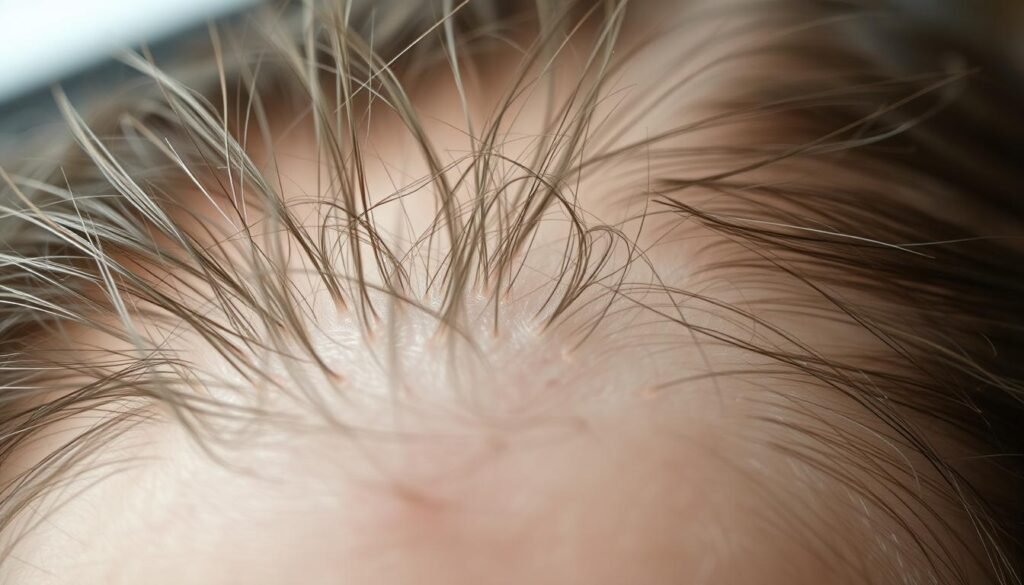
“The earlier you can identify and address the root cause of hair loss, the better your chances of restoring healthy, vibrant hair.”
The Psychological Impact of Hair Loss and Recovery
The experience of hair loss can have a profound impact on an individual’s self-esteem and body image. Many people struggling with thinning hair or balding report feelings of embarrassment, anxiety, and a diminished sense of self-worth. The emotional triggers associated with this condition can be deeply personal and challenging to navigate.
As hair plays a significant role in one’s physical appearance and identity, its loss can often lead to a disruption in personal and social interactions. Individuals may find themselves avoiding social situations or experiencing a decrease in confidence, which can further exacerbate the psychological burden of hair loss.
However, the journey of hair recovery can be a transformative one, offering individuals the opportunity to reclaim their self-esteem and positive body image. With the support of medical professionals, natural remedies, and a focus on self-care, many have found ways to manage the emotional impact of hair loss and successfully regrow their hair.
FAQ
Can stress cause hair loss?
Yes, stress can be a significant contributor to hair loss. High levels of stress can trigger a condition called telogen effluvium, which causes increased shedding of hair. Stress can elevate cortisol levels, which can disrupt the normal hair growth cycle and lead to excessive hair thinning or balding.
How does stress affect hair growth?
Stress can have a detrimental effect on hair growth in several ways. Elevated cortisol levels, a hormone released during stress, can interfere with the normal hair growth cycle, causing more hair follicles to enter the resting (telogen) phase prematurely. This can lead to excessive shedding and thinning of the hair.
What are the signs of stress-related hair loss?
The primary signs of stress-related hair loss include increased shedding, noticeable thinning of the hair, and a general feeling that you are losing more hair than usual. You may notice more hair in your hairbrush, on your pillow, or in the shower drain. Stress can also cause the hair to become more brittle and prone to breakage.
How can I manage stress to prevent hair loss?
Implementing effective stress management techniques can help prevent or reduce stress-related hair loss. Some recommended strategies include:
– Practicing relaxation methods, such as meditation, yoga, or deep breathing exercises
– Engaging in regular physical activity, such as exercise or sports
– Getting adequate sleep and maintaining a healthy sleep schedule
– Seeking support from friends, family, or a mental health professional
– Identifying and addressing the root causes of stress in your life
Can hair regrow after stress-related shedding?
Yes, in many cases, hair can regrow after stress-related shedding. Once the underlying stress is properly managed and cortisol levels return to normal, the hair growth cycle can resume, and new hair can start to grow. The rate and extent of regrowth will depend on various factors, including the individual’s age, overall health, and the duration and severity of the stress-induced hair loss.
When should I see a doctor for stress-related hair loss?
It’s a good idea to consult a healthcare professional, such as a dermatologist or trichologist, if you experience persistent or excessive hair shedding that lasts for more than a few months. They can help determine the underlying cause of your hair loss and provide appropriate treatment recommendations, which may include addressing the stress factors, prescribing medications, or recommending specialized therapies.
